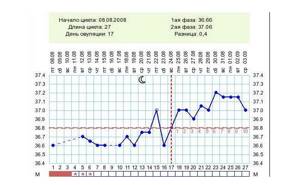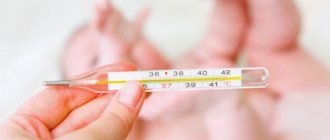Many women who want to conceive a child as soon as possible try different methods in order to find out about their interesting situation even before the absence of their next period. Basal temperature during pregnancy in the early stages before the delay can show that fertilization has occurred, since BT levels during gestation differ from usual. To obtain reliable results, it is important to take measurements correctly and if strange thermometer marks appear, immediately contact a specialist.
What is basal temperature
Basal temperature is the values identified by measuring it on the surface of the mucous tissues of the body. Translated from Greek, the word basal means “basic”.
The values obtained as a result of measurements are the closest to the temperature inside the body, and physiological basal temperature is a natural indicator recorded in healthy representatives of the fair sex.
In modern times, few women use the method of measuring temperature to diagnose pregnancy, although in the early stages of pregnancy it shows the result of unprotected sexual intercourse with high accuracy.
To increase the reliability of measurements, it is necessary to read thermometer readings obtained from mucous tissues in a calm state.
BT can be measured in the following natural holes:
- vagina;
- anus;
- mouth.
Measurements in the mouth and vagina are not very accurate, so most women record thermometer readings obtained by measuring in the rectum.
The use of ultrasound and ultra-sensitive pregnancy tests have made the method of measuring basal temperature not as popular as before, but with its help it is possible to track the moment of ovulation and conception at home.
Reasons for decreased basal temperature
Surely, many women preparing to become mothers are wondering what temperature can be called low? According to the recommendations of doctors, you should worry if the thermometer drops below 37º C. The reason for this can be very serious complications, and you should definitely not hesitate to contact a specialist.

First of all, you need to calm down and take your temperature again, following all the instructions. If the thermometer readings are still disappointing, there is no need to panic ahead of time. Wait a few hours, as a one-time drop in temperature may well be related to your general condition.
Try measuring it again after three to four hours. Is the thermometer less than 37º C? It is already dangerous to delay going to the doctor for a medical examination, but it is still fixable. If the reason for the decrease in basal temperature is a lack of progesterone, the pregnant woman is sent to hospital and the necessary measures begin immediately. In approximately 90% of such cases, doctors manage to save the life of the unborn baby, and after some time healthy toddlers are born. You can save your pregnancy even if spotting appears.
In addition, low temperature can be a signal of a so-called frozen pregnancy, when the fetus stops developing in the womb. The corpus luteum cannot cope with its functions, as a result of which the level of progesterone in the female body drops sharply, which, in fact, helps to reduce the temperature. It should be remembered that a frozen pregnancy is not always accompanied by a low temperature, so thermometer readings cannot be used as the only diagnostic method.
Why is BT measured?
Base temperature allows you to obtain information about how a woman’s hormonal levels change depending on the stage of the menstrual cycle:
Follicular phase
The phase begins on the first day of menstruation and lasts on average 14 days (normally 7–21 days, depending on the length of the cycle). Due to the increased production of estrogen, the follicles mature, in one of which the egg will develop. A few days before ovulation, the hormone level rises sharply, and the basal temperature drops by 0.2-0.3 °C, since estrogen does not affect its changes as pronouncedly as progesterone;
Luteal phase
The phase begins immediately after the ovulatory phase; it is by the values obtained during measurements at this time that one can judge whether pregnancy has occurred. The luteal stage is controlled by progesterone; it is necessary for the growth of the endometrium of the uterus, so that if the gamete is fertilized, it can penetrate the wall of the reproductive organ. Progesterone triggers an enhanced process of thermoregulation, which is why the temperature in the luteal phase begins to rise.
If conception does not occur in the second phase, the indicators will drop to normal before the start of the next period. If pregnancy occurs, a competent temperature measurement will help you find out about this fact even before your menstruation is delayed - it will be increased.
In addition to self-diagnosis of pregnancy, recording BT will help:
- find out whether the concentration of estrogen and progesterone in the body is normal;
- track exactly when the follicular phase ends and the egg is released into the uterus;
- diagnose disorders of the reproductive system organs and cycle failures;
- suspect any problems with early pregnancy;
- guess about the presence of an inflammatory process in the pelvic organs, which is the cause of long unsuccessful attempts to get pregnant.
It is necessary to consult a gynecologist if a woman does not notice a sharp change in temperature during the ovulatory phase or BT increases by less than 0.4 °C. This indicates a hormonal disorder, as a result of which the egg does not mature inside the follicle, does not enter the uterus, or the progesterone needed for its implantation is produced in insufficient quantities. With these problems, a woman can make efforts to get pregnant and carry a baby, but they are not successful.
Why measure basal temperature and how to do it?
The menstrual cycle in a woman of reproductive age consists of two phases. The first is called follicular and covers the period before ovulation. The second - luteal - after ovulation. The onset of ovulation is a transition period between these phases.
When a couple is planning a pregnancy, or, on the contrary, wants to postpone it for now, it is necessary to know the days of ovulation . To do this, you can use basal temperature measurement. According to its data, it is determined whether ovulation has occurred or not; its regularity indicates the normal functioning of the woman’s reproductive system and the possibility of becoming pregnant these days.
Many women try to use this method without fully understanding what is happening to their body at this time. To obtain reliable results, basal temperature must be measured daily in the morning, immediately after waking up. A prerequisite is at least 5-6 hours of uninterrupted sleep. Having woken up, you cannot get out of bed, so it is advisable to put a thermometer nearby and measure your temperature while lying down.
Measurements can be taken in different ways: through the mouth, as well as vaginal and rectal methods . For more accurate results, it is advisable not to change the thermometer and the way you measure temperature at least during the same cycle. It is preferable to use a mercury thermometer rather than an electronic one. In this case, the old method will be more reliable.
In order to correctly interpret the results, a graph is drawn up based on the daily data obtained , lasting several menstrual cycles. Using it, you can observe changes in the body and find out your basal temperature. These data can be compared with average normal values. You can also show this data to your doctor. They may be needed when diagnosing certain gynecological diseases, planning pregnancy, and choosing contraceptive methods.
The first (follicular) phase of the menstrual cycle is not similar to the second due to the difference in temperature dynamics. In the first phase, normal basal temperature values range from 36.3 to 36.8. Its slight decrease occurs a few days before ovulation. After its onset, the temperature rises to 37-37.2 degrees and remains the same during the entire second half of the cycle. A couple of days before menstruation, another slight decrease occurs by one or two tenths of a degree, and then menstruation begins.
Currently reading: Rubella during pregnancy
How to take measurements correctly
In order to build a BT schedule during pregnancy before a delay, it is important to carry out measurements correctly, because each woman’s body is individual and very susceptible to minimal changes in the external environment. Temperature fluctuations of even one tenth of a degree are important for assessing the health of the reproductive system and the proper development of the fertilized egg in the early stages.
Rules for measuring BT:
- It is better to take measurements immediately after waking up, without getting out of bed, between 05:00 and 07:00 am - at this time the maximum peak of hormone production is observed.
- It is advisable to measure the temperature in the rectum, and not in the mouth or vagina - this may cause inaccurate results.
- Use an accurate thermometer, preferably a mercury thermometer rather than an electronic one, since even a tenth of a degree is important when recording temperature. It should be stored in a place that is easy to reach, and past results should be shaken off in the evening.
- Measure BT by holding the thermometer in the rectum for at least five minutes, the insertion depth is 2–3 cm. During the measurement, you should not turn around or sit up in bed, after which you must write down the result.
- Take measurements after a full sleep lasting at least 5-6 hours in a row.
- If the night before taking the temperature, a woman ate fatty, spicy food, had sex, slept poorly, or took an airplane flight, it is important to enter this information in the notebook with the results. Intimate contacts should be avoided 5–6 hours before fixing BT.
In case of an acute viral or bacterial infection, when the body temperature is at high levels, it is not recommended to measure BT, since the data will be incorrect.
How to measure correctly
- Start your measurements on the first day of your menstrual cycle (as soon as your period starts). The equipment for this is the most common thermometer.
- Duration of measurement - 5 minutes with a mercury thermometer or 3 minutes with an electronic one, place - rectum.
- Perform this procedure in the morning immediately after waking up, at the same time. If necessary, use an alarm clock. It's important to wake up and take your basal temperature at exactly the same time every morning . On the weekend, you can simply take your temperature and go back to sleep.
- Every action you take after waking up can affect your core body temperature. Therefore, refrain from morning conversations and kisses with your husband. Measurement comes first.
- For greater information content, a rest of at least three hours . So if you get up during the night three hours or less before the time you usually wake up, this may be a good time to take a measurement.
Normal temperature indicators before and after fertilization
If you know what thermometer readings should be at different phases of the cycle, you can easily determine the period of ovulation and select a time favorable for conception. Normal BT values are presented in the table.
| Cycle phase | Cycle days | Predominant hormones | Normal BT values |
| Follicular | 1–12 | Estrogen | 36.2–36.6 °C |
| Ovulation | 13–14 | Estrogen, follicle-stimulating, luteinizing | Decrease to 36.2–36.3 °C Follicle rupture 36.4–36.7 °C After ovulation 37-37.4 °C |
| Luteal | 15–28 | Progesterone | 37.1–37.4 °C |
If fertilization has occurred, the following fluctuations will be visible on the BT measurement graph:
- The day of fertilization is 36.4–36.7 °C, the changes are not yet noticeable, only after 5–7 days, when the fertilized egg enters the uterine cavity, the indicators rise to 37-37.3 °C.
- Introduction of the embryo into the uterine wall - temperature decrease by 0.2-0.4 °C (implantation retraction). 4-5 days after implantation - BT indicators increase above 37 °C.
- For the next one to two weeks, the temperature remains at 37-37.5 °C, but should not fall below.
Based on inflated BT values just before the start of the expected menstrual period, a woman can guess that she is pregnant, even if other early signs of conception (breast swelling, nausea) are absent. After a delay, the fact of conception can be confirmed by a pregnancy test.
Temperature chart depending on the stage of pregnancy
The increase in basal temperature during pregnancy before the delay is shown with examples in the table below, depending on the time elapsed from conception. The increase in indicators is explained by the production of the hormone progesterone by the corpus luteum. This temporary organ is formed at the site of a follicle that has burst and released a mature egg. The temperature will remain elevated until, in the event of pregnancy, the corpus luteum functions and does not atrophy - this happens at 12–15 weeks, when the placenta is formed.
| Conception time | Midwifery week | Standard BT in °C | Possible reasons for deviations |
| 1 | 3 | 37-37,5 | Decreased – risk of miscarriage, increased – presence of inflammatory process |
| 2 | 4 | 37,1–37,5 | |
| 3 | 5 | 37,1–37,7 | |
| 4 | 6 | 37,1–37,7 | If the readings drop and then a sharp rise in temperature to 37.9–38 °C, a frozen pregnancy can be suspected |
Pathological basal temperature
The thermometer readings do not always correspond to different phases of the cycle and are normal - this may indicate a change in the woman’s health status. On the forums, reviews of basal temperature indicators during early pregnancy, recorded before the delay in pregnant women, confirm the possible causes of deviations in the presence of the following factors:
- Inflammatory process in the pelvic organs - an increase in temperature is recorded on days when normally it should, on the contrary, become lower (before and during menstruation).
- Deficiency of progesterone production - manifests itself as a lower than normal temperature for the luteal phase (less than 37 ° C).
- Physiological characteristics of the female body - if at a certain stage of the cycle the temperature is slightly lower or higher than normal (by 0.1-0.3 °C), but all natural peaks are present in the graph, measurement errors may be to blame.
- Spontaneous ovulation - an increase in temperature, which should be on schedule during the release of the egg into the uterus, is observed earlier or later than this period. The reason is a shift in the cycle due to hormonal imbalances and somatic diseases.
- Repeated ovulation occurs in 7–10% of cases. Two eggs mature in the follicles, which can be released simultaneously or in turn into the uterus. In this case, two peaks of increase in BT are observed.
Based on the increase in BT and then its decrease after confirmation of pregnancy, a threat of miscarriage can be suspected.
Reasons for rising temperature:

- infections and inflammatory processes;
- endocrine diseases;
- hormonal imbalances;
- blood diseases.
However, in the vast majority of cases, raising the temperature above normal is an effective defense in the fight against infection, since with hyperthermia there is an increase in the rate of metabolic processes and biochemical reactions, vasodilation, which results in accelerated elimination of harmful substances due to active sweating and increased blood circulation , increasing urine output. An important factor is that hyperthermia creates conditions for the death of microbial bodies.
We recommend reading: Urinalysis during pregnancy, Third screening during pregnancy, Can a gynecologist determine pregnancy during examination?
In addition to high fever in a pregnant woman due to ARVI, other symptoms of the disease are added, in particular severe headache, drowsiness, sore throat, runny nose, aches throughout the body, and cough. ARVI is insidious in the development of complications in the form of pneumonia, tracheitis, laryngitis, otitis. Viruses can easily penetrate the placental barrier and negatively affect the fetus. Against the background of infection, spontaneous miscarriage occurs, or various malformations occur.
We also recommend reading: Pregnant woman’s exchange card
An increase in body temperature, even a slight one, is dangerous before childbirth, as it can cause the expectant mother to develop various complications from the heart and nervous system. There is a risk of infection for the baby during childbirth. In most cases, women wonder how to reduce fever during pregnancy. And today we will look at this question and perhaps help some who have not yet found the answer to it.
Firstly, you need to remember that not all medications can be used during pregnancy; they can have a bad effect on your unborn baby. The temperature can only be brought down with paracetamol. But you can take it no more than four times a day. Pregnant women are also allowed to use Viburkol suppositories. But the well-known and popular among many people for bringing down the temperature, aspirin or its other name, acetylsalicylic acid, is strictly prohibited for pregnant women. It can reduce blood clotting, which can cause bleeding in both the pregnant woman and the baby. Also, its use leads to the appearance of developmental defects in the child. Pregnant women can also use folk remedies to bring down the temperature. These include:
- Drink plenty of fluids. You can drink green tea, cranberry juice, tea with raspberries, lemon, milk with the addition of one spoon of honey, chamomile infusions. But those who have a tendency to edema need to be careful; such people should not drink a lot of liquid, especially in the last stages of pregnancy.
- Wiping with vinegar or water. This method works well against temperature, but the water temperature should not be too cold; the water for this case should be made at room temperature. It is good to put cold compresses on the forehead.
Physiological and dangerous results of BT measurements in early pregnancy
What should be the normal basal temperature during pregnancy, before the delay? It ranges from 37 to 37.5 °C; low or too high readings should be a reason to consult a doctor. The sooner a woman confirms the fact of conception using reliable methods (hCG blood test, ultrasound), the greater the chance of saving the embryo and prolonging pregnancy if problems are observed in the early stages.
Fever
Exceeding normal thermometer levels is caused by the following reasons:
- violation of BT measurement rules;
- therapy with hormonal drugs for long-term infertility or in preparation for IVF;
- infections occurring against the background of an increase in temperature (flu, sore throat, otitis media, etc.);
- inflammatory processes of the ovaries and uterus;
- ectopic location of the embryo;
- late period of frozen pregnancy.
When pathological conditions are manifested not only by an increase in BT, but also by a general deterioration in well-being, it is necessary to seek help from specialists as soon as possible.
Decrease in thermometer readings
It is imperative to visit a doctor, because low BT can signal problems:
- risk of miscarriage;
- spontaneous abortion that has begun;
- frozen pregnancy.
Lower temperatures compared to normal may be the result of natural characteristics of the body - if during ovulation there was a peak BT of 36.7–36.8 ° C, then after conception the indicators will be at 36.9 or 37 degrees.
Low basal temperature during pregnancy
If a woman is of reproductive age and is capable of conceiving children, then normally her menstrual cycle is divided into two phases: the first - before ovulation, and the second - after it. Ovulation is an important milestone in each cycle, and in addition to the possibility of getting pregnant, it provides a lot of information about the state of women's health.
The processes occurring in a woman’s body before and after ovulation differ significantly in their characteristics and significance, so it is not strange that the body temperature is recorded differently in different phases. Every woman knows that to determine ovulation, basal body temperature (in the rectum) is measured.
In the first phase of the cycle, it averages 36.6-36.8 degrees. Immediately before ovulation, it decreases by a few tenths of a degree, and on the day of ovulation it increases sharply - to 37 and above. An elevated basal temperature indicates the onset of ovulation and persists until the end of the second phase, that is, until menstruation begins. On the eve or on the day of the next menstruation, it decreases again.
Why is this happening? From the moment of ovulation, a woman’s body begins to intensively produce progesterone, which creates favorable conditions for the potential onset, maintenance and development of pregnancy. Due to these hormonal fluctuations, many changes occur. Among other things, increased progesterone levels also affect body temperature, raising it slightly. These indicators persist until menstruation, and if conception has taken place, then during the first four months. A decrease in BT at the beginning of pregnancy may indicate a threat of termination.
An increased basal temperature in the first weeks and months of pregnancy within 37-37.5 degrees is a good sign: a woman’s body produces enough progesterone for the pregnancy to continue and the baby to develop. But don't panic if your readings during pregnancy are lower than indicated.
More on the topic
Basal temperature during ovulation
What is the basal temperature during pregnancy?
Basal temperature during pregnancy before delay
Basal temperature during pregnancy
Basal temperature in early pregnancy
The onset of ovulation and probable fertilization is indicated by an increase in basal temperature by at least 0.4 degrees compared to the first phase. Such a jump is sufficient and does not give cause for concern. If your basal temperature is below 37, but at least 0.4 degrees higher than the temperature of the first phase of the cycle, then you most likely have no need to worry either. The main thing is that your health and tests are normal. This can reassure women who kept a basal temperature chart before pregnancy and have something to compare the indicators with. But what about those who just now, having already become pregnant, began to measure BT for the first time in their lives, because the doctor advised or ordered so?
For starters, also calm down and don’t be nervous. Anxiety and stress definitely do not benefit you and your unborn baby, and everything is not yet clear with basal temperature.
Firstly, BT is considered truly indicative only during the period of egg implantation, which occurs 6-12 days after its fertilization. Although basal temperature should remain elevated throughout the first 4 months of pregnancy, in most cases doctors do not recommend measuring it beyond the first 4 weeks. Less often, gynecologists believe that it is necessary to keep BT levels under control until 12 weeks of pregnancy. But in any case, at such a time frame they are no longer as informative as at the beginning.
Secondly, basal temperature itself means almost nothing. The woman’s well-being, the presence or absence of other signs of miscarriage, test results and the conclusion of an ultrasound, which should be performed if there is an existing threat, all play a role. If everything is in order, the fetus is developing well and the mother feels great, then a low basal temperature during pregnancy should not cause panic.
Moreover, an elevated basal temperature does not yet guarantee a normal pregnancy. Other indicators are extremely important to assess her condition. Therefore, be sure to take all factors into account.
In the end, remember that each body is individual, and it has the right, among other things, to have a basal temperature that differs from accepted norms. Many women safely bear children with BT levels well below 37 degrees. However, make sure that it does not fall below 36.5.
In addition, consider what thermometer you use to measure your basal temperature. It is known that electronic thermometers show approximately 0.2 degrees less than traditional mercury thermometers. Of course, BT must be measured according to all the rules. If you haven't taken this into account, be sure to study them.
However, it is a completely different matter if the threat of miscarriage is confirmed by other indicators besides low basal temperature. In this case, the doctor will prescribe you hormonal therapy (usually Duphaston or Utrozhestan) to artificially increase and maintain the level of progesterone in the body in order to maintain pregnancy. But keep in mind that it is not at all necessary that the basal temperature rise to 37 degrees or higher. It may remain at low levels - don’t worry.
Especially for beremennost.net - Elena Kichak
When to worry
Dangerous symptoms that should alert a woman in the early stages of pregnancy include:
- leakage of scarlet or dark brown bloody secretion from the vagina;
- increased tone of the uterine walls - accompanied by a feeling that the stomach has become like stone;
- sudden disappearance of previously manifested symptoms of conception - nausea, breast enlargement (the mammary glands become soft and return to their previous size);
- sharp deterioration in general condition;
- heat;
- fever, chills;
- severe vomiting;
- acute pain in the lower abdomen;
- feeling of pressure in the anus;
- a sharp drop in blood pressure.
If deviations in the basal temperature chart during early pregnancy are accompanied by dangerous signs before the delay, you must call an ambulance or go to the hospital yourself.
Ectopic pregnancy
In fact, an ectopic pregnancy is not much different from a normal one, only the development of the fetus begins not inside the reproductive organ, but in the ovary, fallopian tube or peritoneum. A fetus that is fixed in the wrong place does not inhibit the production of progesterone by the corpus luteum, so thermometer marks when measuring BT may be normal and correspond to early gestation. In such a situation, relying on the results of a pregnancy test is not informative - it may show one stripe, two bright ones, or one bright and the other pale.
Temperature readings will begin to deviate from the norm only at 4–5 weeks of gestation, when the fetus reaches a larger size.
The growing embryo injures the fallopian tube, causing the development of an acute inflammatory process and hyperthermia.
Ectopic pregnancy also manifests itself with the following symptoms:
- frequent vomiting;
- blood pressure drops sharply;
- fainting;
- severe abdominal pain.
The pain is not relieved by taking medications and becomes even worse after the fallopian tube ruptures.
Frozen pregnancy
If the development and growth of the embryo stops, it dies. The corpus luteum stops producing progesterone, which is why normal BT levels tend to drop to 36.3–36.9 °C. It is impossible to diagnose fading pregnancy on your own; this should be done by a specialist after conducting an examination. When BT remains normal, but the fetus still dies, additional symptoms include nagging pain in the lower abdomen, first dark red and then greenish discharge from the genital tract, indicating infection of the uterus and the development of endometritis.
Threat of spontaneous abortion
When the basal temperature at conception remains at 36.8–36.9 °C until the delay, this indicates a lack of progesterone. If the hormone is produced in small quantities, even if the embryo is implanted, it will not be able to stay normally inside the uterus due to its contractions and will be rejected. It is necessary to go to the hospital if you additionally experience spotting from the vagina and a pulling sensation in the abdomen - these indicate the onset of fetal rejection and miscarriage.
The fetus can be saved if the patient is prescribed medications containing progesterone in time to continue pregnancy.
Measuring basal temperature is not the only way to determine days favorable for conception and pregnancy. But it is a good help in self-diagnosis of ovulation, the beginning and end of different phases of the cycle and menstruation. The longer a girl measures her BT, the easier she will be able to navigate the resulting graphs and promptly contact a doctor if she suspects that she has health problems.
When should you go to the doctor?
- If the temperature stays the same for a whole month - either too low or too high.
- If in the 2nd half of the cycle the readings increased very slightly (by 0.4 degrees or even less).
- If according to the calendar you are ovulating, and your temperature is in no hurry to rise.
- If the phases of the cycle are shorter than 11 days or longer than 18.
- If there are no periods or suspicion of pregnancy.
Is it worth continuing to keep a schedule for a pregnant woman?
As a rule, basal temperature is measured by those wishing to become pregnant (or by women whose faith prohibits other types of contraception). When a desired pregnancy occurs, it is not necessary to keep a chart of this temperature. However, it will not be superfluous, as it will allow you to control your hormones.
Doctors advise: take your temperature for about 3 more months, and you will protect yourself from an unexpected termination of pregnancy.
- An increase in basal temperature in the 1st trimester (more than 37.7 degrees) – perhaps there is inflammation somewhere in the body.
- Decreased (less than 37 degrees) – there is a likely risk of miscarriage.
Both of these “bells” are an urgent reason to go to the antenatal clinic.
As for the 2nd and 3rd trimesters, at this time your basal temperature drops, and you can forget about the thermometer and your usual schedule for a long time... Until planning your next baby!











